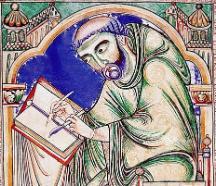Writing Art in the Middle Ages, 700-1400
Overview
This module will introduce students to the textual sources of medieval art history, documents written during the Middle Ages that discuss visual and material cultures. The objects and images of the Middle Ages were not mere trinkets adorning the lives of the rich, but held an agency that was addressed and discussed by contemporary artists and audiences. Medieval material culture embodied ideas, passions, and a desire to communicate sacred and profane facets of human experience.
In this module, students will study a range of manuscripts, wall-paintings, sculpture, pilgrim badges, architecture, and many more sources created between 700-1400. In parallel with this visual focus, students will engage with a variety of medieval texts to guide them through the role of images at the time; for instance, writings from the church fathers, Jewish authors, late medieval mystics, and twelfth-century teachers. All these people and communities had an opinion about art in their world. From this exploration we will ask a range of questions: why does the mystic Margery Kempe focus on the materiality of objects in her writing; why do some Jewish manuscripts contain images of living things, despite a commandment forbidding them to do so; and what does a church ‘mean’, if anything? These questions address the very heart of the Middle Ages, challenging the notion of a particularly medieval way of making and reading art.
The new proliferation of texts translated into English makes it possible to do this course without expertise in a medieval language, and you will be able to take advantage of this dynamic area of research. Students will gain experience in working with both text and images to answer research questions, experience which will help in many other contexts and subjects.
Aims
By the end of the module, students should have acquired:
- Awareness of a variety of methodological perspectives and their application to the Middle Ages.
- A profound knowledge of medieval primary texts and their application to contemporary medieval visual sources.
- Confidence in the identification and analysis of relationships between texts and images.
- Confidence in the written and spoken presentation of research findings and conclusions.
Preliminary Reading
Primary sources include:
- Abbot Suger, Abbot Suger on the Abbey Church of St.-Denis and its Art Treasures, trans. Erwin Panofsky, 2nd ed (Princeton, 1979).
- Theophilus, The Various Arts = De diversa artibus (Oxford, 1986).
- Conrad Rudolph, The ‘things of greater importance’: Bernard of Clairvaux’s Apologia and the medieval attitude toward art (Philadelphia, 1990); Hugh of Saint Victor, The
- Mystic Ark: Hugh of Saint Victor, art, and thought in the twelfth century, trans. Conrad Rudolph (New York, 2014).
- Guillaume Durand, The Symbolism of Churches and Church Ornaments: a translation of the first book of the Rationale divinorum officiorum (London, 1893)
- Margery Kempe, The Book of Margery Kempe, Anthony Bale ed. (Oxford, 2015)
Secondary sources include:
- Laurance G. Duggan, ‘Was Art Really the ‘Book of the Illiterate?’ in Marielle Hageman, Marco Mostert ed., Reading Images and Texts (Turnhout, 2005), pp. 63-108.
- Mary Carruthers, The Experience of Beauty in the Middle Ages (Oxford, 2013).
- Laura Cleaver, Education in Twelfth-Century Art and Architecture (Woodbridge, 2016).
- Umberto Eco, Art and Beauty in the Middle Ages (New Haven, 1986).

Module information
- Module title
Writing Art in the Middle Ages, 700-1400- Module number
HOA00080M- Convenor
For postgraduates
- Handbooks
- MA Modules 2023-2024
- Assessment
- Postgraduate funding
- PhD/MPhil supervision and training
- Resources
- Student activities
